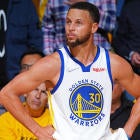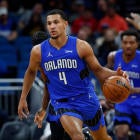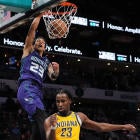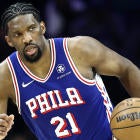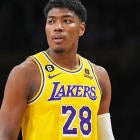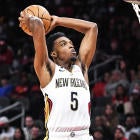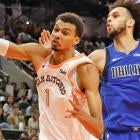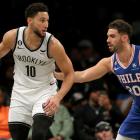
Tiering is one of the most popular ways to prepare for a Fantasy basketball draft. Within each position group, separating players into tiers is an effective means of projecting general value and keeping organized during your draft. If you're in a position where you need to make a quick decision, consulting a set of tiers can help settle the debate between two players who are relatively close in value.
Entering the 2022-23 season, the NBA's talent pool is deeper than ever, so going into your drafts with a plan is more imperative than ever. Early on, drafting the top talents should be the priority, but as the draft progresses, it's important to be cognizant of which positions you're stocking up on and which you'll need to target in the mid-to-late rounds. Tiers can help achieve the roster balance most fantasy managers are hoping to come away with.
Here are our point guard tiers, which can serve as a general guide for those playing in standard leagues.
Tiers assume eight-category settings. Each player only appears in one set of tiers. Players are assigned to the position at which they're likely to play the most.
TIER 1
The reigning Finals MVP is coming off of a down year, by his standards, in which both his shooting efficiency and raw scoring numbers took a notable tumble. But despite posting the worst field goal and free throw percentages of his entire career, Curry was still the No. 7 overall fantasy player on a per-game basis. He'll turn 35 in March, but coming off of a strong postseason run, there's reason to believe Curry's scoring and shooting numbers can return to their normal levels.
The narrative around Harden was overwhelmingly negative last season, and yet he was once again a top-five player in per-game value and a top-10 player in total value. Whether you like his game or not, there's no debate that Harden is a maddeningly consistent fantasy producer who gets to the line a ton and has virtually no weaknesses in his stat profile. He may never return to the heights of his peak Rockets days, but Harden remains a safe first-round value.
Is this the year Doncic's fantasy value finally aligns with his place as a top-five player in the NBA? In terms of pure counting stats, Doncic is as productive as anyone, but his combination of average free throw shooting and high volume (7.5 FTA/G last season) conspire to bring down his value in category leagues. With the way the Mavs' roster is shaping up, Doncic will be leaned on more heavily than ever. If he can bump that free throw percentage up closer to 80 percent, he could easily be a top-five overall player.
Young continued to shine as one of the league's top point guards last season, ranking fourth among qualified players with 27.2 points per game and third with 9.7 assists per contest. It may be difficult for Young to replicate his numbers in the coming campaign, however, now that Atlanta has added Dejounte Murray to its backcourt. The move was largely made to give the Hawks another ball handler and playmaker, which sounds good from a team perspective but not so much from a fantasy angle. That's not to say that Young should be expected to experience a precipitous statistical drop -- he's too good for that. However, he probably isn't going to post a 33.3 percent usage rate (fourth-highest in the league) again now that he's sharing the backcourt with Murray.
TIER 2
Fantasy managers who drafted Lillard last year got burned. The All-Star point guard played in just 29 games as he dealt with chronic abdominal pain. When it was clear Lillard wasn't returning, Portland made some major roster changes to tank the remainder of the season. The biggest move was dealing Lillard's longtime backcourt mate, CJ McCollum, to the Pelicans. Josh Hart represented the best returning player in the deal and Hart could start at small forward in 2022-23. Portland also dealt for Jerami Grant while re-signing both Anfernee Simons and Jusuf Nurkic. Given that the 32-year-old returned first-round value for four straight years before last, it's reasonable to draft him in the late first round. Some managers may be scared off by his injury and age, but his floor is extremely high given his skill and role within the Blazers' offense.
Ball took his game to another level during his second season in the league, averaging 20.1 points, 6.7 rebounds, 7.6 assists and 1.6 steals per game. While his 42.9 percent shooting from the field was underwhelming, he shot 87.2 percent from the free-throw line, which was an increase of more than 11 percentage points compared to his rookie season. The Hornets have not made any significant moves around him during the offseason, and the stars look to be aligning for another big season from Ball.
Coming off of a strong rookie season, expectations were fairly high for Haliburton, but not even his biggest supporters would have predicted a top-10 finish in total value. Part of the equation, of course, was that Haliburton played 77 games – 77 is the new 82 in the modern NBA – but he also racked up 8.2 assists and 1.7 steals per game while shooting 47.3 percent from the field. Now the focal point of a rebuild in Indiana, Haliburton should have the green light to function as the Pacers' top playmaker – and perhaps their top scorer. After coming over from Sacramento at last season's deadline, Haliburton posted 17.5 points, 9.6 assists, 1.8 steals, 4.3 rebounds and 2.2 threes in 36.1 minutes per game.
Garland made a leap from Year 1 to Year 2, but he made an even bigger leap last season, when he posted 21.7 points, 8.6 assists, 3.3 rebounds, 1.3 steals and 2.6 threes per game en route to finishing as a top-25 fantasy value. It may be difficult for Garland to make another sizable leap, but at the very least he should be able to sustain last year's production. From March 1 onward (23 games), Garland averaged 25.0 points, 9.7 assists and 1.7 steals per contest.
One of the most consistent guards in fantasy basketball, VanVleet has finished 17th, 23rd and 30th, respectively, in total value over the last three seasons. Field goal percentage will always be his downfall, but VanVleet makes up for it with elite production in steals, threes and assists. VanVleet hasn't dipped below 1.7 steals per game since 2018-19, and his three-point volume continues to rise with each passing season (3.7 3PM/G in 2021-22).
TIER 3
At this point in Irving's bizarre career, he's deserving of his own tier – and he'd probably prefer it that way. As has been the case for the last several years, Irving is typically a first-round value on a per-game basis, but he's simply been far too unreliable to justify that level of investment. Since leaving Cleveland, Irving has played 60, 67, 20, 54 and 29 games, respectively, over the last five seasons. Draft the 30-year-old at your own risk.
TIER 4
Thus far in his NBA career, Morant's real-life value has exceeded his Fantasy value, but that began to change last season. After finishing outside the top 100 in 2020-21, Morant rocketed up to 30th in per-game value in 2021-22, thanks in large part to a huge bump in scoring (19.1 PPG to 27.4 PPG), as well as boosts in field goal, three-point and free throw percentage. The next step for Morant will be increasing his three-point volume (1.5 3PM/G last season) and continuing to improve at the charity stripe (76.1% FT).
While the Suns' season ended with a thud, it overshadowed the fact that Paul continues to perform at an extremely high level into his late-30s. The veteran led the league in assists for the first time since 2014-15 and finished as a top-25 fantasy asset for the third straight season. At some point, the 37-year-old is going to slow down, but as long as he's able to stay healthy he'll be worth an early-round pick.
Shai Gilgeous-Alexander, Thunder
On a per-game basis, Gilgeous-Alexander is coming off of the best season of his career, but he once again missed significant time due to injury. After playing 82 and 70 games in his first two years in the league, Gilgeous-Alexander has appeared in only 91 games over the last two seasons. If this is the year he can finally stay healthy – he's only 24 years old – Gilgeous-Alexander could crack the top 25 for the first time.
An early injury resulted in last year's No. 1 overall pick getting off to a slow start, but as the season progressed it was easy to see why Cunningham was billed as a future superstar. By April, Cunningham worked his way into the top-50 in total value behind 17.4 points, 5.6 assists, 5.5 rebounds, 1.2 steals, 1.8 threes and 0.7 blocks per game. Cunningham is already extremely polished for his age, but he should be able to improve upon his three-point shooting and his field goal percentage, which jumped to 45.7 percent post-All-Star-break. Detroit added talent this summer, but make no mistake: this is Cunningham's show.
TIER 5
When it comes to year-over-year fantasy production, few players are as consistent as Holiday. The defensive ace has been a top-50 player in 10 straight seasons, and he's spent the last five inside the top 30. The one knock on Holiday is his pedestrian free throw percentage for a guard (career 76.3%), but other than that he's an ultra-dependable source of points, rebounds, assists, threes and steals.
We're now entering Year 6 of the De'Aaron Fox hype tour. Every year, he's a popular breakout candidate, and while he continues to grow into a very good NBA player, Fox has finished the last three seasons 110th, 50th and 88th in total fantasy value. Last season felt like a slight step back for the Kentucky product, who saw drops in points, assists, steals and threes per game, as well as three-point percentage. At 24, Fox is still plenty young enough to justify the hype, but at some point, he needs to become a significantly better three-point (career 32.0%) and free throw (career 72.5%) shooter.
Murray is a difficult evaluation after missing all of last season due to a torn ACL. His rehab process took longer than anticipated, but by all accounts, he should be back at full capacity when the preseason opens in October. Some fantasy managers may opt for safer options in the early-mid-rounds, but prior to the injury, Murray was a top-35 fantasy asset in 2020-21.
D'Angelo Russell, Timberwolves
Russell is not without his flaws, though he proved last season that he's able to coexist alongside Karl-Anthony Towns and an emerging star in Anthony Edwards. While the addition of Rudy Gobert is another variable, if anything the trade helped clear out some of Russell's competition for minutes. Injuries will always be a concern – he's played 65, 42 and 45 games over the last three years – but when healthy Russell is a good source of points, assists and threes. He's also registered at least 1.0 steals per game in six of his seven NBA seasons.
In his first season with the Bulls, Ball got off to a fantastic start, hitting 3.1 threes per game while vying for the league lead in total steals. However, a midseason knee injury derailed his campaign, and the subsequent recovery process has been less-than-encouraging. As of publication, it's very much unclear if Ball will be ready for the start of training camp. Either way, Ball has already reached the point in his young career where he can safely be penciled in for 15-to-20 missed games, at minimum.
The veteran missed a decent chunk of time and showed signs of regression, but by the end of the season he turned in yet another top-65 fantasy finish. At this stage of his career, Lowry is clearly past his prime, but he should continue to be a strong source of assists, free throws and threes while also chipping in points, rebounds and steals.
TIER 6
Brunson signing with the Knicks in free agency was one of the biggest storylines of the summer. However, from a fantasy perspective, there's a case to be made that he landed in an inferior fantasy situation. Sure, Brunson gets away from one of the league's highest-usage players in Luka Doncic, but he now finds himself sharing touches with RJ Barrett and Julius Randle. At the end of the day, it's probably a wash, but fantasy managers shouldn't expect a major leap forward.
After yet another season derailed by injuries, Brogdon finds himself as the likely sixth man in Boston following an offseason trade. Given how the last five seasons have ended, perhaps a change of pace – and a lesser role from night to night – is exactly what Brogdon needs at this stage of his career. It's essentially a given that Brogdon's numbers will drop across the board, but the hope is that the statistical decline is met by a tangible increase in games played.
Kevin Porter, Rockets
Houston appears to be moving forward with Porter as its starting point guard alongside Jalen Green. While the long-term viability of that pairing is very much in question, Porter should again be set for big minutes on what will likely be a very bad team. Last season, that role led to 15.6 points, 6.2 assists, 4.4 rebounds, 1.1 steals and 2.5 threes per game, though Porter was a major percentages-killer (41.5% FG; 64.2% FT).
Last season was an unmitigated disaster for Westbrook. There's no getting around it. It was a shocking and yet completely predictable fall from grace for a player who averaged 22.2 points, 11.5 rebounds and 11.7 assists per game two seasons ago. For fantasy managers, the best-case scenario is probably trade to a bad team that would be willing to let Westbrook resume running the show and racking up meaningless counting stats.
The case for Jones is very much a speculative one, but in the wake of the Dejounte Murray trade, the Spurs look to be prepared to hand the reins over to the Duke product. In 11 starts last season, Jones averaged 13.5 points, 7.5 assists, 4.6 rebounds and 1.1 steals per game while shooting 48.8 percent from the field (32.7 MPG). The major drawback, of course, is that Jones is a complete non-factor from three (10-51 3PT last season). But as long as the minutes are there, the assists and steals production could push him toward top-100 value.
A small guard with a unique stat profile, Anthony snuck into the top-100 last season behind 16.3 points, 5.4 rebounds, 5.7 assists, .07 steals and 2.0 threes per game. For the second straight year, he failed to crack 40 percent shooting, but he helped offset it with a strong free throw percentage (85.4%) on decent volume (3.9 FTA/G). The 2020 first-round pick will again be a key factor in the Magic's rotation, but with Jalen Suggs and Markelle Fultz back healthy, plus the addition of Paolo Banchero, it's fair to wonder how much his role will diminish.
The veteran began to show real signs of decline last season, and he enters 2022-23 facing considerable uncertainty as the Jazz appear to be heading toward a full teardown. Whether he remains in Utah or not, Conley should be approached with caution in drafts. Over his final 30 games last season (including playoffs), Conley posted just 11.7 points, 5.4 assists and 3.1 rebounds on 39.1 percent shooting.












